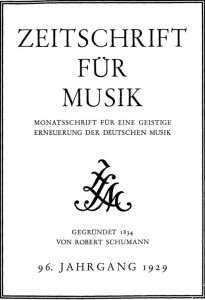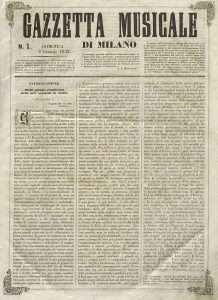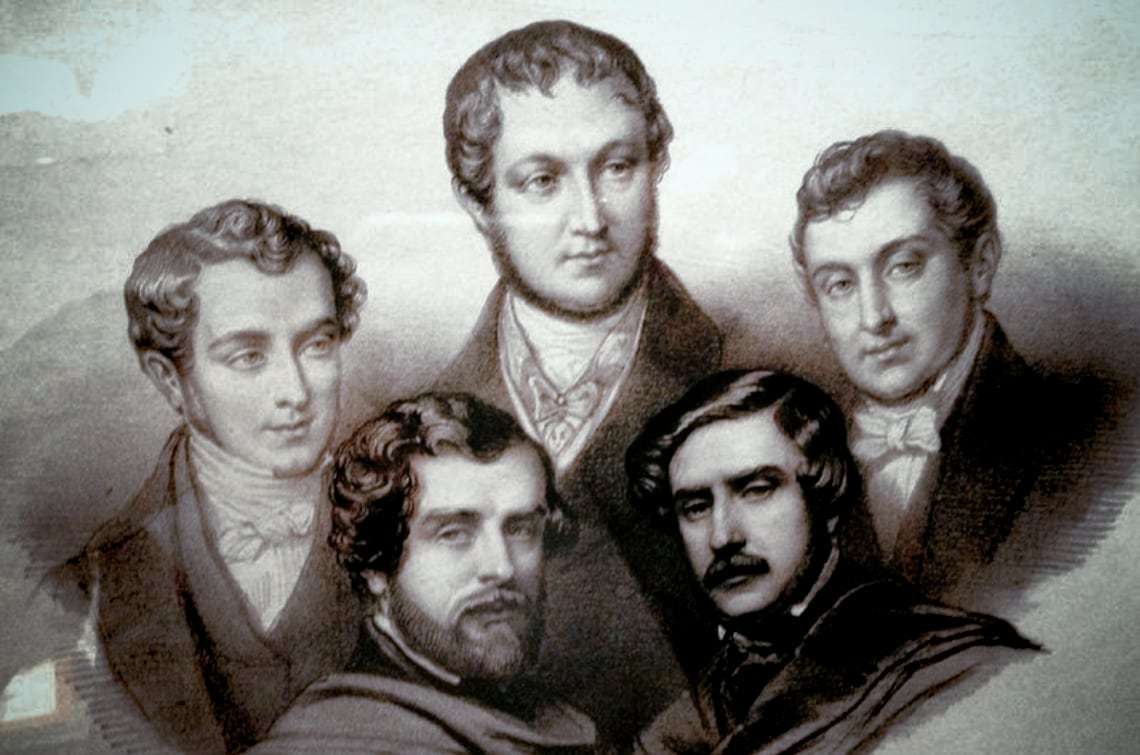Article index
When was the musical and vocal critic born?
The phenomenon of vocal critic, and with it the figure of the critic, has recent origins. Organizing speeches on music, which are as ancient as civilization, in a specific sector, the one that gravitates around musical journalism and which materializes in reviews, reports, news on executions, and so on, begins in the eighteenth century , with the birth of a specialized press on whose pages they wrote musicologists, musicians, writers and journalists whose activities was then recognized as a criticism.
The musical and vocal critic of the origins is a musician himself, or a writer: it is therefore located in the list of professionals and intellectuals.
 In 1834 "Neue Zeitschrift Für Musik" (" New Music Magazine "), still active today, which remained for ten years starting from its foundation under the direction of Robert Schumann. Just this great musician represents the most complete example of the critic of origins. His style, in balance between an absolute musical competence and a brilliant communication capacity, remains exemplary even today .
In 1834 "Neue Zeitschrift Für Musik" (" New Music Magazine "), still active today, which remained for ten years starting from its foundation under the direction of Robert Schumann. Just this great musician represents the most complete example of the critic of origins. His style, in balance between an absolute musical competence and a brilliant communication capacity, remains exemplary even today .
Schumann founded a music criticism that is expressed in the name of romanticism, aimed at expanding the horizons of music and truth that it can transmit, to the heart and mind. To this end, he chooses a prose full of images and metaphors, periphrasis, high registers, use of ways of saying and aphorisms, thus connecting music criticism to literature very closely. In short, inaugurates a "creative" critical language that tries to put itself in parallel to the creative act itself, with the aim of revealing the essence of the work and the reasons that led the author to express themselves in that way.
What is the difference between the musical critic of the past and that of today?
It is important to note a big difference between the figure of the musical critic at the origins and that of today. Being a critic at Schumann's time meant, in fact, more than expressing itself regarding the execution of repertoire songs, considering the news, and often discovering and promoting new authors, of the caliber of Chopin, Berlioz, Brahms, among those that Schumann with the His criticisms contributed to "launch". In short, the critic dealt with the great extent of new music and emerging musicians, a task that, at least as regards classical music, is no longer among the main ones today.
Furthermore, since the record market and the activity of the critic did not yet exist, even if it was explained in specialized magazines, it was not linked to journalism but remained an expression of critics who in turn were artists, criticism had an exquisitely cultural sense of analysis pure.
The critic of the origins, refined intellectual, very often also a musician, thus found himself holding the double and contradictory function of educator and diffuser of taste, but also of the guarantor of the elitist of music.
Also in Italy in the nineteenth century the newspapers dedicated to the voice spread, in which criticism has a major part. Even in Miscellanean magazines many articles dedicated to voice and music appeared, often organized in special sections. These publications contributed significantly to the affirmation of a new musical culture, directing the methods of use of music, in short, playing that pedagogical role that, as will be seen better later, contemporary criticism is losing.
What were the press examples linked to music criticism?
 Before the unification of Italy, in the various states we find various examples of printing interested in music criticism. musical gazette pioneering , which comes out with a few numbers in Naples between 1838 and 1839, and above all the 'Florence music magazine' and the 'Music Gazzetta of Milan', which come out at the beginning of the following decade, represent the point of arrival of a rapid evolution that in the previous two decades has seen the births that are completely dedicated to the musical and theatrical news, which generally come out one or several times a week and which, in most cases, respond to the model Typical journalistic of the Gazzette: a few pages, text organized in several columns, no image, many news of various weight and nature .
Before the unification of Italy, in the various states we find various examples of printing interested in music criticism. musical gazette pioneering , which comes out with a few numbers in Naples between 1838 and 1839, and above all the 'Florence music magazine' and the 'Music Gazzetta of Milan', which come out at the beginning of the following decade, represent the point of arrival of a rapid evolution that in the previous two decades has seen the births that are completely dedicated to the musical and theatrical news, which generally come out one or several times a week and which, in most cases, respond to the model Typical journalistic of the Gazzette: a few pages, text organized in several columns, no image, many news of various weight and nature .
What also emerges to a rapid observation is that the Italian musical and vocal critic of the origins is tendentially a writer . Generally this type of critic offers chronachistic reports embellished with personal observations accompanied by a beautiful style, witty and sensitive comments, which however exulate an in -depth speech concerning for example the historical, biographical, aesthetic, theoretical and techniques implications relating to the works represented and their authors .
To give some illustrious examples, the Parmale Leoni can be mentioned, poet and playwright, who worked as a critic for the Florentine literary and scientific periodical "Anthology"; Tommaso Locatelli who took care of the criticism on the "Gazzetta di Venezia" and the scapigliato writer Giuseppe Rovani who cared for the musical news on the "Gazzetta di Milano" and collaborated on "Italy's Italy".
As an example of a miscellaneous newspaper that made use, for the musical part, of the contribution of valid writers, we mention the Venetian "Il Gondoliere, a newspaper of Amena Conversation", which came out from 1833 to 1848, attesting to "one of the most valid one Venetian periodicals, especially for the treated musical and operistic topics.
The affirmation of the practice of vocal criticism goes hand in hand, in Italy, with the popularity of lyrical music and the construction of new theaters capable of hosting it, in many Italian cities, from the major to the smallest. It is no coincidence that the first specialized newspapers, born around the middle of the century, are mainly dedicated to the work: among these, the "Music Gazzetta of Milan", published by memories, which began publications in 1842; "Musical Italy: Giornale dei Teatri, of literature, fine arts and varieties", another Milanese periodical (1847-1859); the "Music Gazzetta of Naples" (since 1852); the "Music Gazzetta of Florence" (since 1853); Fiorentina "The harmony: organ of musical reform in Italy: newspaper of sciences, letters, arts, theaters, concerts and varieties" (1856-1859).
In the second half of the nineteenth century, a process of professionalization of critics begins, which corresponds to a greater development of the same due above all to the factor already mentioned in the great success of the opera. In this regard, it is observed incidentally that while in other European countries, following the romantic revolution, the compositional commitment focused on the intensification of the expressiveness and freedom of instrumental music, which also met the favor of the public , in Italy the musical interest concentrated everything on the melodrama, no longer just a worldly leisure based on the virtuosity of the singers, but the work in which to identify and to participate intensely, in an atmosphere of growing passions that closely touched the experience of the spectators.
That is, on this basis, focusing on the opera, several value musical journalists emerge whose main activity is precisely critics. Among these, Alessandro Biaggi, who was also a composer but dedicated himself mainly to the teaching of music and collaboration as a vocal critic with different newspapers, including "Gazzetta d'Italia", "Gazzetta del Popolo", "New Anthology "," Music Gazzetta of Milan "," The independent "," The nation ". Biaggi carried out an in -depth critical discourse of refusal of the Wagnerian model, wondered about the state of music in Italy, and underlined the need to historically contextualize music.
In the first half of the twentieth century the profession of the critic stands and consolidated. This is the most fruitful period for Italian criticism, full of big names among which Luigi Ronga, Guido Pannain, Andrea Della Corte, and many others are nodded.
To understand the seriousness with which vocal criticism was taken into consideration in this period, the motivation with which the President of the Commission of the National Award of the National Academy of Lincei for the criticism of art and poetry, Vincenzo Arangio-Ruiz is read with the President of the Commission of the National Academy Prize , proposed Ronga for the assignment of the prize in 1957, then won by them. Arangio-Ruiz stated that he had achieved first-rate critical results, demonstrating a shrewd methodological awareness of a vast knowledge of his subject.
Bibliography and notes:
- On Schumann Critic, see Rattalino P., Introduction to Schumann R., The critical writings , Unicopli, Milan, 1991.
- Capra M., Periodicals and music criticism between the nineteenth and twentieth centuries: from the "Universal Censor of theaters" to the "Music Review" , in M. Capra, F. Nicolodi (edited by), Music criticism in Italy in the first half of the twentieth century , Marsilio, Venice, Casa della Musica, Parma, 2011, p. 13
- On this point, see Rattalino P., Literati and Music in the Italian nineteenth century, "Third Program" , 1972. It should be noted that in Italy the tendency to write about music by literati also remains in the twentieth century: just think of writers such as Massimo Bontempelli And Alberto Savinio, and to the poet Eugenio Montale, who from 1954 to 1967 worked as a musical critic of the "information courier".
- Capra M., Periodicals and music criticism between the nineteenth and twentieth centuries: from the "Universal Censor of theaters" to the "Music Review" , cit., P. 14.
- On Rovani's musical critic activity, see Tordi, R., Lindoro's mantle. Rovani and the Opera House , Bulzoni, Rome, 1995
- See Capra M., The press found: two hundred years of musical periodicals, in A. Rigolli (edited by), The musical dissemination in Italy today , Edt, Turin, 2005.
- Sveccadori c .., for Aldo Noseda: The musical critic , "Acme", 1-2, 2013, pp.139-176: 142.
Read also the article: Yalda Yazdani tells the female Afghan free song








